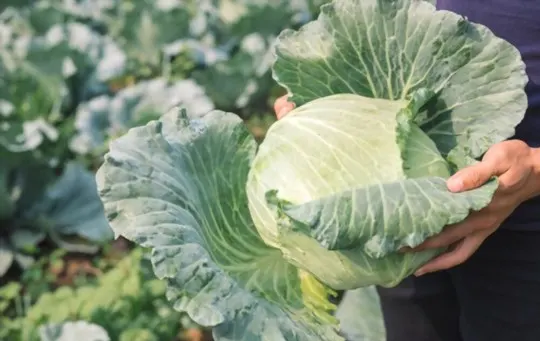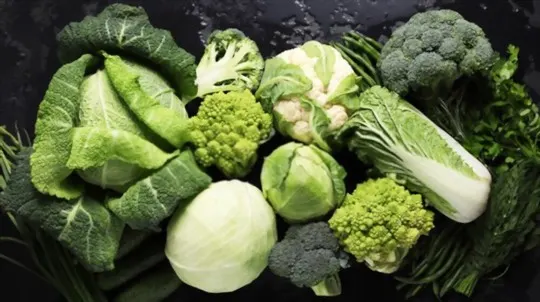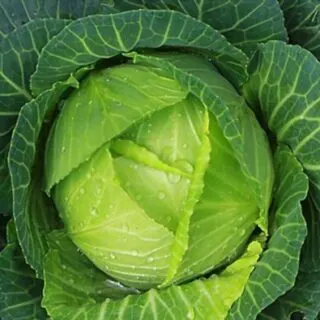Do you ever find yourself in the grocery store, wondering how long your cabbage will last?
You’re not alone! We have all experienced the perplexing dilemma of trying to determine just how long a vegetable like cabbage can stay fresh.
It’s a common question but don’t worry; we’ll answer it for you right here!
In this detailed blog post, we’ll explore everything there is to know about storing and preserving cabbage so that your produce stays crisp and tasty for as long as possible.
What’s Cabbage?

Cabbage is a leafy green or purple vegetable that belongs to the cruciferous family of plants.
This group also includes broccoli, cauliflower, Brussels sprouts, and kale.
Cabbage is an annual plant, meaning it only grows for one season and then dies.
It’s a cool-weather crop, so it’s often planted in the spring and harvested in the fall.
It is a very versatile vegetable.
It can be eaten raw, cooked, steamed, or fermented.
It’s often used in coleslaw or as a topping for salads and sandwiches.
Cabbage is also used in many traditional dishes, such as sauerkraut, Irish stew, and kimchi.
Cabbage is a good source of vitamins C and K, as well as fiber and potassium.
It’s low in calories and fat, making it a healthy addition to any diet.
How Long Does Cabbage Last?

Cabbage can last for a couple of weeks if it is stored properly.
Make sure to keep it in the fridge, and check on it frequently to see if it has gone bad.
There are a few ways to tell if cabbage has gone bad.
The first way to tell if cabbage has gone bad is by the color.
If the cabbage is starting to turn brown, then it has gone bad and you should throw it away.
Another way to tell if cabbage has gone bad is by the smell.
If the cabbage smells sour or unpleasant, then it has gone bad and you should not eat it.
If you see any mold on the cabbage, this is a sure sign that it has gone bad and you should throw it out immediately.
If the cabbage is wilted or limp, this is also a sign that it is no longer good to eat.
If you follow these guidelines, you should be able to tell when cabbage has gone bad and know when to throw it out.
Can You Freeze Cabbage?

You can freeze cabbage, but it’s not the best way to preserve this vegetable.
Cabbage is best when eaten fresh, but freezing it is a good way to extend its shelf life.
When freezing cabbage, you should blanch it first.
Blanching helps to preserve the color and texture of the cabbage.
To blanch cabbage, simply boil it in water for two minutes then remove it and plunge it into ice water.
Once the cabbage is cooled, drain it and pat it dry with a paper towel.
Then, place the cabbage in a freezer-safe bag or container and seal it tightly.
Frozen cabbage will last for up to eight months.
When thawing frozen cabbage, always do so in the refrigerator.
Never thaw frozen cabbage at room temperature or in hot water, as this can cause bacteria to grow.
Simply remove the desired amount of cabbage from the freezer and place it in the fridge overnight to thaw.
Once thawed, use the cabbage within two days.
How To Tell If Cabbage is Bad?
Cabbage is a versatile vegetable that can be used in a variety of dishes.
However, like all vegetables, it can go bad if it’s not stored properly.
Here are a few signs to look for that will tell you if your cabbage has gone bad:
- The leaves are wilted or discolored.
- There is mold on the surface of the cabbage.
- The cabbage has an unpleasant odor.
If you notice any of these signs, it’s best to throw out the cabbage and get a new one.
Cabbage that has gone bad can cause gastrointestinal upset, so it’s best to err on the side of caution.
How Can You Extend the Shelf Life of Cabbage?

Cabbage is a hearty vegetable that can last for weeks, especially when properly stored.
Here are a few tips to help extend the shelf life of cabbage and keep it fresh:
- Store in a cool, dry place: Cabbage will last longest when stored in a cool, dry place like the fridge or a root cellar. Avoid storing it in humid places like the pantry or near the stove.
- Wrap loosely in plastic: Wrapping cabbage tightly in plastic can trap moisture and cause it to rot more quickly. Instead, wrap it loosely in plastic or store it in a sealed container with just a little bit of air space.
- Inspect regularly: Check on your cabbage every few days and remove any leaves that look brown or wilted. These can cause the rest of the cabbage to spoil more quickly.
By following these simple tips, you can keep your cabbage fresh for weeks.
What are Some Tips for Storing Cabbage?
If you’re lucky enough to have fresh cabbage from your garden or farmers market, here are some tips for storing it so it will last.
Cabbage is a cool weather vegetable and should be stored in a cool, dark place.
An unheated basement or garage is ideal.
Wrap the cabbage tightly in plastic wrap or place it in a plastic bag before storing.
This will help keep the moisture in and prevent the cabbage from drying out.
Be sure to check on it regularly, as cabbage that has dried out will not last as long.
Cabbage can also be frozen for longer storage.
First, wash the heads and remove any damaged leaves.
Chop the cabbage into smaller pieces, then blanch by boiling for three minutes.
Drain the cabbage and let it cool before placing it in freezer bags.
Squeeze out as much air as possible before sealing the bags.
Frozen cabbage will last for up to eight months.
Conclusion
If you’re wondering how long cabbage lasts or how to tell if cabbage is bad, this post is for you.
Cabbage is a versatile vegetable that can be used in a variety of dishes.
It’s also a source of many nutrients, including vitamins K and C.
However, cabbage has a relatively short shelf life and should be consumed within a few days of purchasing.
This post will teach you how to tell if cabbage is bad and offer some tips for extending its shelf life.

How Long Does Cabbage Last? Does it Go Bad?
Ingredients
- Cabbage
- Air-tight containers or Ziplock bags
- Labels and markers
Instructions
- Store your product in an labelled container in a cool, dark place like the pantry or fridge.
- If your food is frozen, allow it to thaw in the fridge before cooking.
- Make sure to look for signs that your food has gone bad before eating it.

Carrie is a food writer and editor with more than 15 years of experience. She has worked for some of the biggest names in the food industry, including Bon Appétit, Food & Wine, and Martha Stewart Living.
As the Editor in Chief of IntroChicago.com, Carrie oversees all of the content on the site. She also manages the team of contributing writers and editors, who help to create delicious recipes, helpful tips, and informative articles that you’ll find on the site.
A native of the Chicago area, Carrie is passionate about all things food. She loves trying new restaurants and experimenting with new recipes in her kitchen. She’s also a graduate of the Culinary Institute of America, so she knows a thing or two about food!
